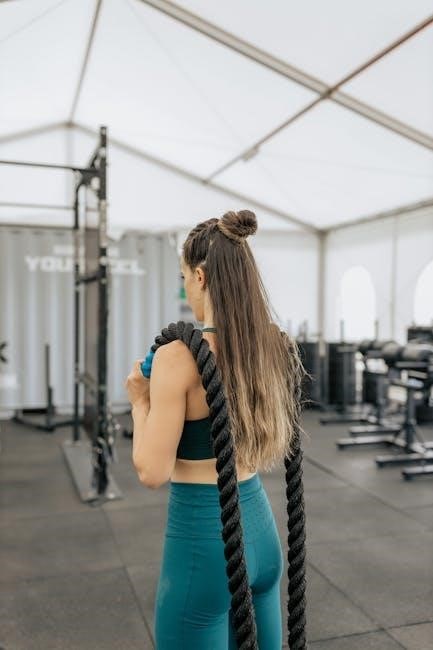6 week hiit workout plan pdf
This 6-week HIIT workout plan is designed for those with limited time and equipment‚ focusing on building muscle‚ strength‚ and conditioning. It includes a free PDF guide with nutrition and recovery tips‚ helping you achieve your fitness goals efficiently.
What is HIIT?
HIIT‚ or High-Intensity Interval Training‚ is a time-efficient workout method involving short bursts of intense exercise followed by brief rest periods. This training style improves cardiovascular fitness‚ burns fat‚ and builds muscle endurance. Its versatility allows for bodyweight exercises‚ minimal equipment‚ or weighted routines‚ making it accessible for all fitness levels. HIIT’s dynamic structure keeps workouts engaging while maximizing calorie burn and physical gains‚ making it a popular choice for those seeking effective and efficient training.
Benefits of a 6-Week HIIT Program
A 6-week HIIT program offers numerous benefits‚ including significant fat loss‚ improved cardiovascular health‚ and enhanced muscle tone. It boosts metabolism‚ allowing your body to burn calories even after workouts. The structured progression helps prevent plateaus‚ while the time-efficient sessions fit into busy schedules. This program also improves mental discipline and overall physical endurance‚ providing a well-rounded fitness transformation in just six weeks.
Why Choose a PDF Format for Your Workout Plan?
Choosing a PDF format for your 6-week HIIT workout plan offers several advantages. PDFs maintain consistent formatting across devices‚ ensuring your workout plan looks the same on your phone‚ tablet‚ or computer. They are easily shareable via email or links and have a small file size‚ saving storage space. PDFs also provide security‚ as they can be password protected to prevent unauthorized edits or sharing. Additionally‚ PDFs can include detailed schedules‚ images‚ and diagrams‚ making them visually engaging and informative. They are accessible offline‚ perfect for gym sessions without internet‚ and are environmentally friendly when viewed digitally. PDFs are also easily updatable‚ allowing for the latest information to be incorporated‚ and are widely compatible across all devices‚ ensuring accessibility regardless of your operating system. Overall‚ PDFs offer a practical‚ organized‚ and flexible way to follow your workout plan.

Understanding the Structure of the 6-Week Plan
This structured 6-week HIIT program is designed to progressively increase intensity and adapt to your fitness level‚ balancing workouts and recovery for optimal results.
Overview of the Weekly Schedule
The 6-week HIIT workout plan is structured into weekly blocks‚ each focusing on specific goals like full-body workouts‚ lower/upper body splits‚ and core conditioning. Each week includes 5 active days and 1-2 rest/recovery days to prevent overtraining. The schedule balances intensity with recovery‚ ensuring progressive overload and adaptation. Days are themed to target different muscle groups and energy systems‚ with exercises varying in duration and complexity. This balanced approach ensures sustained progress and minimizes injury risk while promoting overall fitness.
Progression from Week to Week
The 6-week HIIT plan progresses systematically‚ increasing intensity and complexity weekly. Early weeks focus on foundational movements and building endurance‚ while later weeks introduce advanced exercises and higher-intensity intervals. Each week incorporates variations in rep counts‚ time intervals‚ and exercise combinations to challenge the body differently. Recovery strategies are also adjusted to support heightened demands‚ ensuring continuous improvement without overtraining. This structured progression helps participants adapt and achieve optimal results by the end of the program.
Importance of Warm-Up and Cool-Down
A proper warm-up prepares the body for intense exercise‚ increasing heart rate and flexibility while reducing injury risk. Dynamic stretches and light cardio activate muscles‚ improving performance. Cool-downs‚ including static stretches and deep breathing‚ help lower heart rate‚ prevent dizziness‚ and promote recovery. Both phases are essential for safely transitioning into and out of high-intensity workouts‚ ensuring optimal results and minimizing muscle soreness. Consistency in these routines supports long-term fitness goals and overall well-being.

Week 1: Building the Foundation
Day 1: Full-Body Circuit
This session introduces essential HIIT exercises targeting all major muscle groups. Perform 30 seconds of intense work followed by 30 seconds of rest. Examples include burpees‚ jump squats‚ push-ups‚ and mountain climbers. Repeat the circuit 3-4 times for a 20-30 minute workout. Focus on proper form to maximize efficiency and safety. Adjust the intensity based on fitness level to build endurance and strength progressively. This circuit lays the groundwork for more advanced workouts in upcoming weeks.
Day 2: Lower Body Focus
This session targets the lower body with dynamic exercises to improve strength and endurance. Start with 30 seconds of work followed by 30 seconds of rest. Include squat jumps‚ lunge variations‚ glute bridges‚ and calf raises. Perform 3-4 sets of each exercise to engage the legs and glutes effectively. Maintain proper form to prevent injury and maximize results. Adjust the intensity based on your fitness level to build a strong foundation for more challenging workouts ahead.
Day 3: Upper Body Focus
This session is designed to build strength and endurance in the upper body. Begin with a dynamic warm-up‚ then move into exercises like push-ups‚ burpees‚ and plank variations. Incorporate dumbbells for added resistance in movements such as shoulder presses and chest presses. Perform 30 seconds of work followed by 30 seconds of rest for 3-4 rounds. Focus on maintaining proper form to avoid injury and maximize results. Adjust the intensity to challenge your fitness level effectively.
Day 4: Core and Conditioning
Focus on building core strength and improving overall conditioning. Start with plank variations‚ Russian twists‚ and leg raises to target abdominal muscles. Incorporate HIIT intervals like mountain climbers‚ jump squats‚ and sprints for conditioning. Perform 30 seconds of work followed by 30 seconds of rest for 3-4 rounds. Include dynamic movements to enhance coordination and endurance. Maintain proper form to prevent injury and ensure maximum engagement of the core muscles. Adjust intensity based on your fitness level for optimal results.

Day 5: Active Recovery
Focus on light exercises to aid muscle recovery and improve flexibility. Engage in activities like yoga‚ swimming‚ or brisk walking for 20-30 minutes. Incorporate stretching routines targeting major muscle groups‚ such as hamstrings‚ quads‚ and chest muscles. Foam rolling can help reduce muscle soreness and enhance blood flow. Avoid high-intensity exercises to allow your body to recover. This day is crucial for rebuilding muscle tissue and preparing for the next week’s challenges. Keep the pace steady and focus on relaxation.
Week 2: Increasing Intensity
Build on Week 1’s foundation by introducing more challenging exercises and increasing workout duration. Focus on improving endurance while incorporating varied HIIT routines to enhance overall fitness.
Day 1: Advanced Full-Body Circuit
Push your limits with an advanced full-body circuit‚ focusing on compound movements like burpees‚ jump squats‚ and mountain climbers. This workout targets strength‚ endurance‚ and cardiovascular fitness. Incorporate timed intervals‚ such as 40 seconds of intense work followed by 20 seconds of rest‚ to maximize calorie burn and muscle engagement. Aim for 4-5 rounds‚ adjusting intensity based on your fitness level. Proper form is crucial to avoid injury and optimize results.
Day 2: Plyometric Training
Focus on explosive power with plyometric exercises like box jumps‚ burpees‚ and jump squats. These movements enhance speed‚ strength‚ and coordination. Start with 3 sets of 10-12 reps for each exercise‚ gradually increasing intensity. Proper form is essential to prevent injury. Incorporate short rest periods between sets to maintain a high heart rate. Plyometrics improve muscle reactivity and endurance‚ making them a key component of HIIT for overall fitness improvement and athletic performance.
Day 3: Strength and Endurance
Combine strength-building exercises with endurance-focused HIIT drills. Incorporate compound movements like squats‚ lunges‚ and push-ups‚ paired with intense bursts of cardio such as sprints or jump ropes. Aim for 3-4 sets of 12-15 reps for strength exercises and 45 seconds of all-out effort during HIIT intervals. This blend enhances muscular power while improving cardiovascular stamina. Progress by increasing reps or reducing rest time weekly. Focus on proper form to avoid injury and maximize results. Cool down with stretching to aid recovery.
Day 4: High-Intensity Core Workout
Focus on building a strong‚ stable core with high-intensity exercises. Include planks‚ Russian twists‚ and leg raises to target abs and obliques; Use a 45-second work‚ 15-second rest format for 4-5 sets. Add dynamic movements like bicycle crunches and mountain climbers for a full core challenge. Incorporate superman holds for lower back strength. Keep intensity high to boost metabolism and endurance. Prioritize proper form to prevent injury and maximize results. Finish with deep breathing to stabilize your core and improve posture.
Day 5: Mobility and Flexibility
Focus on active recovery to improve mobility and flexibility. Begin with dynamic stretches like arm circles and leg swings. Incorporate foam rolling to release muscle tension. Transition to static stretches targeting hamstrings‚ quads‚ and hip flexors. Add gentle flows like yoga or Pilates to enhance range of motion. End with light cardio‚ such as cycling or swimming‚ to promote blood flow. Finish with deep breathing exercises to relax and reset for the next week’s challenges.

Week 3: Enhancing Endurance
Focus on improving cardiovascular stamina and muscular endurance. Dynamic stretches‚ cardio-based HIIT‚ and functional training are emphasized to build sustained energy levels and mental toughness effectively.
Day 1: Cardio-Based HIIT
This session focuses on boosting cardiovascular endurance through high-intensity interval training. Exercises like sprints‚ burpees‚ and jump squats are repeated in 30-45 seconds of work followed by 20-30 seconds of rest. The 20-30 minute workout improves heart health‚ accelerates calorie burn‚ and enhances stamina. Incorporate dynamic movements to engage the entire body‚ ensuring maximum effort during each interval. Adjust the intensity and rest periods based on your fitness level to maintain consistency and progressive improvement throughout the week.
Day 2: Functional Training
Functional training focuses on exercises that mimic real-life movements‚ enhancing coordination‚ balance‚ and practical strength. Incorporate movements like medicine ball throws‚ kettlebell swings‚ and plyometric push-ups. Perform 3-4 circuits of 5-8 exercises‚ with 30-45 seconds of work and 15-20 seconds of rest between sets. This session improves overall athleticism and prepares your body for daily activities. Emphasize proper form to avoid injury and maximize efficiency. Cool down with stretching to promote recovery and mobility.
Day 3: Power and Speed Drills
Power and speed drills are designed to boost explosive strength and agility. Incorporate exercises like sprints‚ box jumps‚ and lateral lunges. Perform 4-5 sets of each drill‚ with 20-30 seconds of intense effort followed by 1-2 minutes of rest. Focus on quick movements and maximum effort to enhance muscular power. Include resistance bands for added intensity. Finish with dynamic stretches to improve flexibility and reduce muscle tension. This session accelerates physical performance and mental sharpness.

Day 4: Metabolic Conditioning
Metabolic conditioning focuses on improving the body’s energy systems for enhanced endurance and calorie burn. Perform exercises like burpees‚ jump squats‚ and mountain climbers in 45-second bursts with 15-second rest intervals. Complete 6-8 rounds to maximize metabolic impact. Incorporate bodyweight exercises to target multiple muscle groups. This session boosts metabolism‚ increasing post-workout calorie burn. Aim for a steady pace to build stamina and mental resilience. Conclude with stretching to aid recovery and flexibility.

Day 5: Rest and Recovery
Rest and recovery are vital for muscle repair and performance enhancement. Engage in light activities like yoga or gentle stretching to promote blood flow without overexertion. Focus on hydration‚ nutrition‚ and sleep to support recovery. Avoid high-intensity exercises to allow your body to rebuild. Use this day to recharge mentally and physically‚ ensuring you’re prepared for the upcoming week’s challenges. Proper recovery is key to maximizing progress in your HIIT program.

Week 4: Building Strength
This week focuses on enhancing muscular strength through bodyweight exercises and resistance training. Incorporate progressive overload to increase intensity. Emphasize proper form to prevent injury. Prioritize recovery and nutrition to support muscle growth and endurance.
Day 1: Bodyweight Strength Training
Focus on building strength using bodyweight exercises like push-ups‚ squats‚ lunges‚ and planks. Perform 4 sets of 15-20 reps for each exercise. Incorporate variations to target different muscle groups. Maintain proper form to maximize effectiveness and prevent injury. Gradually increase difficulty by adding depth or range of motion. Finish with a HIIT-style circuit of 30 seconds of work followed by 30 seconds of rest for 3 rounds. This boosts endurance while strengthening muscles.
Day 2: Core and Stability Work
Focus on building core strength and stability with exercises like planks‚ Russian twists‚ and leg raises. Incorporate dynamic stretches to improve flexibility. Use a stability ball for exercises like jackknives and crunches to engage deeper muscles. Perform 3 sets of 12-15 reps for each exercise. Add balance challenges‚ such as single-leg stands or bosu ball training‚ to enhance stability. End with a HIIT circuit targeting the core for 10 minutes to boost endurance and burn fat. Maintain proper form to avoid injury and maximize results.
Day 3: Upper Body Strength Focus
Target your chest‚ shoulders‚ and triceps with exercises like push-ups‚ dumbbell presses‚ and lateral raises. Start with compound movements such as bench presses and overhead presses. Include isolation exercises like bicep curls and tricep dips for detailed muscle development. Perform 4 sets of 8-12 reps for each exercise. Add a HIIT circuit with burpees and mountain climbers to keep the intensity high. Focus on proper form to prevent injury and maximize muscle engagement. Rest for 60-90 seconds between sets to maintain strength output.
Day 4: Lower Body Strength Focus
Focus on building leg‚ glute‚ and core strength with exercises like squats‚ deadlifts‚ and lunges. Incorporate compound movements to target multiple muscle groups simultaneously. Add isolation exercises such as leg presses and calf raises for detailed development. Perform 4 sets of 8-12 reps per exercise. Include a HIIT circuit with jump squats and sprints to boost intensity. Prioritize proper form to avoid injury and ensure maximum engagement. Rest for 60-90 seconds between sets to maintain strength output.
Day 5: Active Recovery Techniques
Focus on low-intensity activities to aid muscle recovery. Incorporate light yoga‚ swimming‚ or cycling for 20-30 minutes. Perform gentle stretching routines‚ targeting hamstrings‚ quads‚ and hip flexors. Use foam rolling or self-myofascial release to reduce muscle tension. Include a short walk or dynamic stretches to promote blood flow. Avoid high-intensity exercises to allow your body to repair and rebuild. This day is crucial for preventing injury and enhancing overall recovery‚ ensuring you’re ready for the next week’s challenges.
Week 5: Maximizing Fat Loss
This phase intensifies workouts to boost metabolism and burn fat. Focus on high-intensity circuits‚ core-cardio combinations‚ and full-body conditioning. Nutrition and recovery strategies are emphasized to enhance results and maintain energy levels.
Day 1: High-Intensity Fat Burning
Begin Week 5 with a dynamic HIIT session designed to accelerate fat loss. Incorporate explosive moves like burpees‚ jump squats‚ and sprints to maximize calorie burn. Alternate between 30 seconds of all-out effort and 30 seconds of rest for 20-30 minutes. This format boosts metabolism and enhances excess post-exercise oxygen consumption (EPOC)‚ helping you burn fat even after the workout. Focus on maintaining proper form to prevent injury and optimize results. Pair with a balanced diet to amplify fat-loss effects.
Day 2: Circuit Training for Weight Loss
Engage in a circuit-style workout combining 8-10 exercises‚ such as bodyweight squats‚ push-ups‚ lunges‚ and planks. Perform each exercise for 45 seconds‚ followed by 15 seconds of rest. Complete 3-4 rounds‚ focusing on intensity and proper form. Circuit training boosts metabolism‚ enhances cardiovascular fitness‚ and targets multiple muscle groups simultaneously. Adjust reps or sets based on fitness level to maximize weight-loss benefits. Maintain a steady pace to keep your heart rate elevated throughout the session.
Day 3: Core and Cardio Combination
Combine core-strengthening exercises with cardiovascular drills to maximize calorie burn and improve stability. Start with 45 seconds of burpees‚ followed by 15 seconds of rest. Repeat for mountain climbers‚ plank jacks‚ and Russian twists. Complete 4-5 rounds‚ focusing on maintaining intensity. Finish with steady-state cardio like jumping rope or cycling for 10-12 minutes. This combination enhances core stability‚ boosts cardiovascular fitness‚ and accelerates weight loss. Keep form precise to avoid injury and maintain consistent effort throughout the session.
Day 4: Full-Body Conditioning
This session focuses on improving overall fitness and endurance through a mix of strength and cardio exercises. Begin with a circuit of push-ups‚ squats‚ and lunges‚ each performed for 45 seconds with 15 seconds of rest. Follow with sprints or rowing intervals for 10 minutes. Finish with planks and leg raises to engage the core. Repeat the circuit twice‚ aiming to increase reps or reduce rest time. This workout enhances muscular endurance‚ cardiovascular health‚ and full-body coordination. Maintain proper form to prevent injury and maximize results.
Day 5: Nutrition and Recovery Focus
Emphasize proper nutrition and recovery to optimize results. Focus on a balanced diet rich in lean proteins‚ complex carbs‚ and healthy fats. Hydration is key‚ so drink plenty of water throughout the day. Incorporate recovery techniques like foam rolling‚ stretching‚ or yoga to reduce muscle soreness. Ensure 7-9 hours of quality sleep to aid muscle repair and recovery. Light activities like walking or swimming can enhance blood flow. Prioritize post-workout nutrition with a protein and carb-rich meal within 30-60 minutes of exercise to replenish energy stores and support muscle growth.

Week 6: Final Push and Progression
Maximize intensity in this final week‚ focusing on advanced exercises and progressive overload. Track your progress‚ celebrate milestones‚ and prepare for long-term fitness success.
Day 1: Advanced Full-Body HIIT
This session combines complex movements and high-intensity bursts to target all major muscle groups. Expect explosive exercises like box jumps‚ burpees‚ and kettlebell swings. Incorporate timed intervals‚ such as 45 seconds of work followed by 15 seconds of rest‚ to maximize calorie burn and improve cardiovascular endurance. Focus on proper form to prevent injury and ensure maximum efficiency. This workout pushes your limits‚ preparing you for the final week’s challenges.
- Box jumps
- Burpees
- Kettlebell swings
- Mountain climbers
- Medicine ball slams
Day 2: Maximum Effort Training
This high-intensity session focuses on maximum effort‚ pushing your physical and mental limits. Expect short‚ explosive exercises like sprints‚ thrusters‚ and jump squats‚ followed by minimal rest periods. The goal is to maximize power output and metabolic stress. Incorporate compound movements that engage multiple muscle groups simultaneously; This workout is designed to test your endurance and strength‚ ensuring progressive overload and significant fitness gains by the end of the week;
- Sprints
- Thrusters
- Jump squats
- Battle ropes
- Box jumps
Day 3: Strength and Power Combo
This session combines strength training with power-focused exercises to enhance muscular endurance and explosive capability. Exercises like deadlifts‚ bench presses‚ and clean-and-presses target major muscle groups for strength‚ while box jumps and medicine ball throws improve power. The combination of heavy lifting and dynamic movements ensures well-rounded development‚ preparing your body for peak performance. Rest periods are minimal to maintain intensity‚ fostering both strength gains and cardiovascular endurance.
- Deadlifts
- Bench press
- Clean and press
- Box jumps
- Medicine ball throws
Day 4: Core and Endurance Challenge
This session focuses on building core stability and boosting cardiovascular endurance through HIIT. Exercises like planks‚ Russian twists‚ and leg raises target the abdominals‚ while burpees and jump squats elevate heart rate. The combination of core strength and endurance training improves overall fitness and enhances athletic performance. Short rest periods keep the intensity high‚ ensuring maximum calorie burn and muscle engagement throughout the workout.
- Plank variations
- Russian twists
- Leg raises
- Burpees
- Jump squats
Day 5: Final Cool-Down and Reflection
Conclude your 6-week journey with a gentle cool-down session. Focus on static stretches‚ foam rolling‚ and deep breathing to aid muscle recovery. Reflect on your progress by tracking improvements in strength‚ endurance‚ and body composition. Celebrate achievements and set new fitness goals. Consider maintaining a consistent routine to sustain results and continue your health journey beyond the program.
- Static stretches (hamstrings‚ quadriceps‚ chest)
- Foam rolling for muscle recovery
- Deep breathing exercises
- Progress tracking and goal setting
Congratulations on completing the 6-week HIIT program! Celebrate your progress and newfound fitness level. Continue your journey by setting new goals and maintaining a consistent routine.
Reviewing Your Progress
Reflecting on your 6-week HIIT journey‚ you’ve likely seen significant improvements in endurance‚ strength‚ and overall fitness. Track how your body has adapted‚ celebrating increased energy levels and fat loss. Use the PDF to compare initial and final measurements‚ highlighting achievements. Notice how workouts that once felt challenging now feel manageable. Celebrate milestones‚ no matter how small‚ and acknowledge the mental toughness developed. This progress is a testament to your dedication and consistency.
Setting New Fitness Goals
After completing the 6-week HIIT program‚ set ambitious yet achievable goals to continue your fitness journey. Consider increasing workout intensity‚ focusing on specific muscle groups‚ or aiming for endurance milestones. Develop a clear vision for your next phase‚ whether it’s mastering advanced exercises or improving overall health. Write down your objectives and track progress to stay motivated. Celebrate achievements and maintain consistency to ensure long-term success in your fitness endeavors.
Maintaining Consistency Post-Program
Consistency is key to sustaining progress after completing the 6-week HIIT program. Aim to incorporate HIIT sessions into your long-term routine‚ even if less frequently. Schedule workouts in advance and stick to them. Adapt the program to suit your lifestyle by adjusting intensity or duration as needed. Track your progress to stay motivated and ensure continued improvement. Mix HIIT with other forms of exercise‚ like strength training or yoga‚ to maintain balance and avoid plateaus. Join a fitness community for accountability and support.
